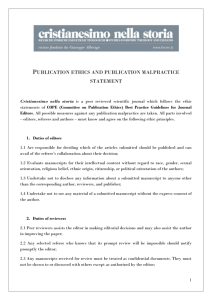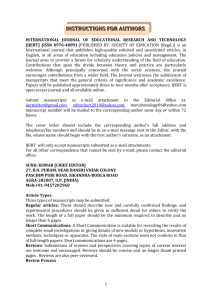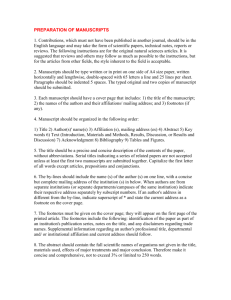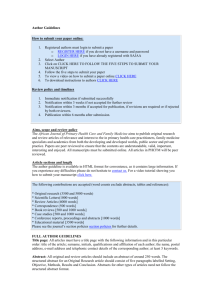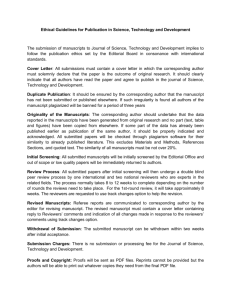- Pacific Group of e
advertisement
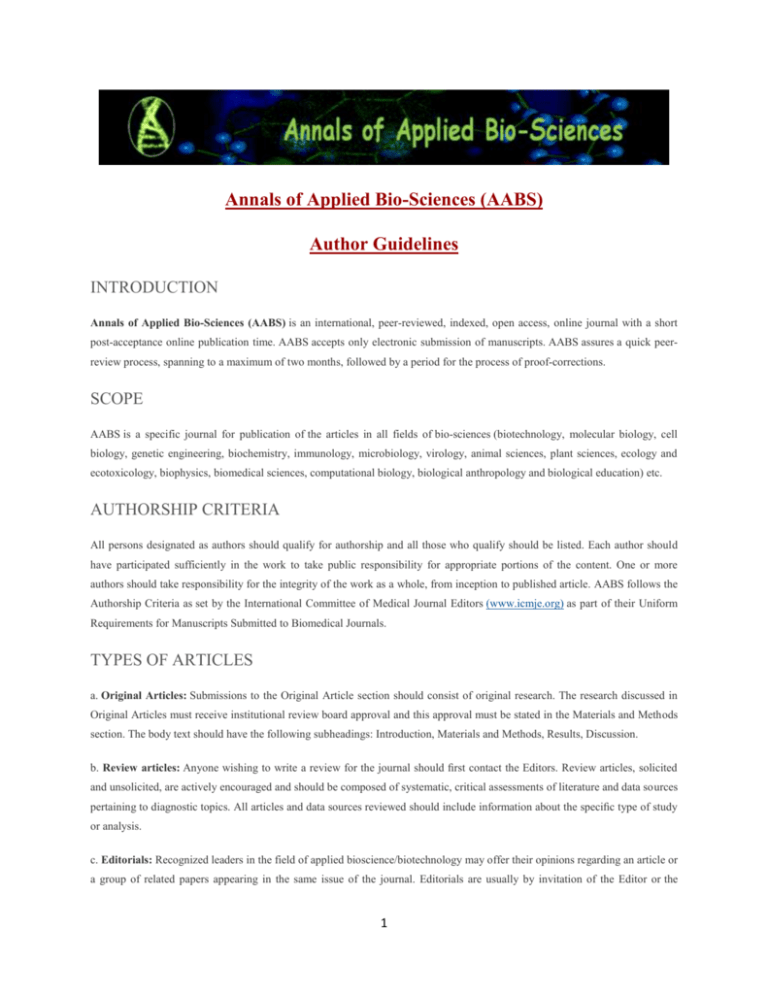
Annals of Applied Bio-Sciences (AABS) Author Guidelines INTRODUCTION Annals of Applied Bio-Sciences (AABS) is an international, peer-reviewed, indexed, open access, online journal with a short post-acceptance online publication time. AABS accepts only electronic submission of manuscripts. AABS assures a quick peerreview process, spanning to a maximum of two months, followed by a period for the process of proof-corrections. SCOPE AABS is a specific journal for publication of the articles in all fields of bio-sciences (biotechnology, molecular biology, cell biology, genetic engineering, biochemistry, immunology, microbiology, virology, animal sciences, plant sciences, ecology and ecotoxicology, biophysics, biomedical sciences, computational biology, biological anthropology and biological education) etc. AUTHORSHIP CRITERIA All persons designated as authors should qualify for authorship and all those who qualify should be listed. Each author should have participated sufficiently in the work to take public responsibility for appropriate portions of the content. One or more authors should take responsibility for the integrity of the work as a whole, from inception to published article. AABS follows the Authorship Criteria as set by the International Committee of Medical Journal Editors (www.icmje.org) as part of their Uniform Requirements for Manuscripts Submitted to Biomedical Journals. TYPES OF ARTICLES a. Original Articles: Submissions to the Original Article section should consist of original research. The research discussed in Original Articles must receive institutional review board approval and this approval must be stated in the Materials and Methods section. The body text should have the following subheadings: Introduction, Materials and Methods, Results, Discussion. b. Review articles: Anyone wishing to write a review for the journal should first contact the Editors. Review articles, solicited and unsolicited, are actively encouraged and should be composed of systematic, critical assessments of literature and data sources pertaining to diagnostic topics. All articles and data sources reviewed should include information about the specific type of study or analysis. c. Editorials: Recognized leaders in the field of applied bioscience/biotechnology may offer their opinions regarding an article or a group of related papers appearing in the same issue of the journal. Editorials are usually by invitation of the Editor or the 1 members of editorial board but may also include the unsolicited analysis of new trends in the practice of applied bioscience/biotechnology or the author’s perspective on articles recently published in AABS or in another journal. SUBMISSION Manuscripts must be submitted by one of the authors of the manuscript, and should not be submitted by anyone else on their behalf. The submitting author (corresponding author) takes responsibility for the article during submission and peer review. It is also the author’s responsibility to ensure that article emanatory from a particular institution and is submitted with approval of necessary institution. Prior to submitting a manuscript, submitting authors should collect electronic files for the manuscript file (including title page and figures), and cover letter. i. Cover Letter All manuscripts must be accompanied by a cover letter. The information in the cover letter will not be supplied to reviewers. Authors are welcomed to suggest three or four reviewers for their paper; however, the editors cannot guarantee assignment of a particular review to a paper. These should be experts in their field, who will be able to provide an objective assessment of the manuscript. Any suggested peer reviewers should not be current collaborators, and should not be members of the same research institution. Suggested reviewers will be considered alongside potential reviewers recommended by the Editorial board. To download the template for cover letter, click here. ii. Manuscript preparation Manuscripts must be submitted in Word (.doc or .docx) file format. Articles should be typed in 12 pt (Times New Roman), double spaced throughout with margins of 2.5 cm, and pages must be numbered. The right margin should be unjustified (ragged). Define abbreviations at first mention in the text and in each table and figure. When using acronyms, make certain the full name is spelled out on first use. Manuscripts must be in accordance with the International Committee of Medical Journal Editors: Uniform Requirements for Manuscripts Submitted to Biomedical Journals (http://www.icmje.org/). The editorial board reserves the right to edit the submitted manuscripts in order to comply with the journal’s style. In any case, the authors are responsible for the published material. The constituents of a manuscript file should be presented in the following order: 1. Title page 2. Abstract 3. Key words 4. Main text 5. Abbreviations and Symbols 6. Acknowledgment 7. Declarations 8. References 2 9. Tables 10. Figures with Figure Legends 1. Title page: The title page should be paginated as page 1 of the manuscript. It should have the information in the following format: Type of article: (Original article, review article, etc.) Title of article: Concise and informative. Titles are often used in information-retrieval systems. Avoid abbreviations and formulae where possible. Running (short) title (< 50 characters ) Author names and affiliations: The title page should include the names, highest academic degree and email addresses of author(s). Generally for uniformity author names should be written as first name, middle name initial followed by surname, e.g. Edward F. Goljan. Present the authors' affiliation addresses (where the actual work was done) below the names. Indicate all affiliations with a lower-case superscript letter immediately after the author's name and in front of the appropriate address. Provide the full postal address of each affiliation, including the country name. Corresponding author: Clearly indicate who is willing to handle correspondence at all stages of refereeing and publication, also post-publication. Ensure that telephone numbers (with country and area code) are provided in addition to the e-mail address and the complete postal address. 2. Abstract: Abstract must be typed on a separate page following the title page. Abstracts must be no longer than 250 words. Do not cite references in the abstract. Non-standard or uncommon abbreviations should be avoided in the abstract, but if essential they must be defined at their first mention in the abstract itself. Do not list anything in the abstract that is not there in the manuscript. Abstract for Original articles should be structured in four sections: background, methods, result and discussion/conclusion. Abstract for review article may be structured or unstructured as appropriate for the sections of the paper. 3. Key words: The authors should list 4 to 6 key words or phrases. These key words should be representative of your article and are used for indexing services and other search facilities for published material. 4. Main text: Separate pages should be used for the remaining sections of the text. AABS can only accept manuscripts written in English. Spelling should be US English or British English, but not a mixture. There is no explicit limit on the length of articles (original article, review article and editorial) submitted, but authors are encouraged to be concise. Original articles should be organized in four main headings: introduction, material and method, results, and discussion/conclusion. Subheadings or subdivisions of the main headings may be used for clarification in larger and more detailed articles, but should be limited to key aspects. If a brand name is cited, supply the manufacturer's name and address (city and state/country). Give sources (name of company and location) for all special reagents (e.g. antibodies, enzymes, probes). 5. Abbreviations and Symbols: Use only standard abbreviations. The full term for which an abbreviation stands should precede its first use in the text. 3 6. Acknowledgment: All contributors who do not meet the criteria for authorship should be covered. It should include persons who provided technical help, writing assistance and departmental head that only provided general support. Financial and material support and conflict of interests must be written in this section. Authors should obtain permission to acknowledge from all those mentioned in the Acknowledgements section. 7. Declarations: This information must also be inserted into your manuscript under the acknowledgements section with the headings below. If you have no declaration to make please insert the following statements into your manuscript: • Funding: None • Competing interests: None declared 8. References: The author(s) are responsible for the accuracy of the references. Each reference should be numbered and listed according to their order in the text (do not alphabetize). They should be referred to Arabic numerals in superscript with square bracket after the punctuation marks (e.g. Singh et al [5]). References cited only in tables or in legends to figures should be numbered in accordance with the sequence established by the first identification in the text of the particular table or figure. Please avoid excessive referencing. Only articles that have been published or are in press may be included in the Reference section. References should be arranged according to the "Uniform Requirements for Manuscripts Submitted to Biomedical Journals" rules developed by "International Committee of Medical Journal Editors (ICMJE)". Some examples have been provided for frequently used reference types. The www.nlm.nih.gov/bsd/uniform_requirements.html site should be used for guidance on other types of references not provided here. Journal titles should be abbreviated according to Index Medicus. Refer to the "List of Journals Indexed in Index Medicus" for abbreviations of journal names, or access the list atwww.nlm.nih.gov/tsd/serials/lji.html . Use complete name of the journal for non-indexed journals. Abbreviations are not used for journals not in the Index Medicus. All authors should be quoted for papers with up to six authors; for papers with more than six authors, the first six should be quoted followed by et al. Sample references are given below: a. Article in journal: Author(s) name (more than 6 names use et al). Title of article. Abbreviation of title of journal Year;Volume:Page. Example: Goyal P, Sehgal S, Agarwal R, Singh S, Gupta R, Kumar A. Ossifying fibromyxoid tumor - Diagnostic challenge for a cytopathologist. Cytojournal. 2012;9:17. b. In press article: Author(s) name (more than 6 names use et al). Title of article.Abbreviation of title of journal, in press. Example: Kumar A, Goyal P, Seghal S, Agrawal D, Kumar V, Singh S. Giant immature teratoma of ovary with gliomatosisperitonei in 15 year-old girl: a case report and literature review. J Gynecol Surg. in press. c. Chapter of book: Author(s) name. Chapter. In: Editor(s) name. Book.Edition. Place: Publisher; Year: Page. Example: Meltzer PS, Kallioniemi A, Trent JM. Chromosome alterations in human solid tumors. In: Vogelstein B, Kinzler KW, editors. The genetic basis of human cancer. New York: McGraw-Hill; 2002. 93-113. d. Book: Author(s) name. Book.Edition. Place: Publisher; Year. Example: Murray PR, Rosenthal KS, Kobayashi GS, Pfaller MA. Medical microbiology. 4th ed. St. Louis: Mosby; 2002. 9. Tables: Each table must be typed double-spaced on a separate page following the references. Smaller spacing and font may be used within tables, but the font style should match that of the text. Do not justify the text. Tables should be kept to a necessary minimum, and their information should not duplicated in the text. Each table should be numbered and cited in sequence using 4 Arabic numerals (i.e. Table 1, 2, 3 etc.). Each table must include appropriate headings and Footnotes. Abbreviations/acronyms used in a table must be defined in a footnote below the table. Units of measurement must be clearly indicated. 10. Figure with Figure Legends: All figures (illustrations, images, or photographs) should be numbered sequentially in the text with Arabic numbers (i.e., Fig 2, Figs 2, 4–6) and should be referred to in parentheses within the text. During submission of an article, authors should include all figures in the main body of the manuscript in word file format. Figures should not be submitted in separate files. If the manuscript is accepted for publication, authors will be asked to provide the figures in TIFF or JPEG formats. The resolution must be set to at least 300 DPI (dots per inch). Writing any text on the figures should be avoided as much as possible. A short detailed legend should be provided for each figure. Legends for the illustrations should be typed double spaced with each figure. Stains and magnifications should be specified for all photomicrographs. Abbreviations and symbols used in the figures must be denoted in the legend. PERMISSIONS Authors wishing to include figures, tables, or text passages that have already been published elsewhere are required to obtain permission from the copyright owner(s) for both the print and online format and to include evidence that such permission has been granted when submitting their papers. Any material received without such evidence will be assumed to originate from the authors. ARTICLE PROCESSING CHARGES (APC) Pacific Group of e-Journals, the parent organization of Annals of Applied Bio-Sciences (AABS), is a self-supporting organization and does not receive funding from any institution/government. Hence, the operation of the AABS journal is solely financed by the processing fees received from authors. To know more about APC, click here. DISPOSAL OF MATERIAL Once published, all copies of the manuscript, correspondence and artwork will be held for one year before disposal. Rejected manuscripts will be held for one month before being disposed of. RELATIONS WITH EDITOR(S), AUTHOR(S) AND REVIEWER(S) Editors do not share information regarding articles (article receipt, review process, referee opinions or final results) with anyone except authors and reviewers. Reviewers and editorial board members cannot discuss articles in a public manner. Reviewers’ reviews cannot be printed or disclosed. Care is taken to keep the identities of the reviewers undisclosed. All articles submitted will be subjected to peer review by the editorial board, and the authors will be informed as soon as possible about the editorial decision. Editorial board reserves the right to make some revisions in the article. Revised articles should also be accompanied by a unique letter with responses to reviewers' comments. PEER REVIEW POLICY 5 Peer review process is single-blinded i.e. the reviewers know who the authors are, but authors do not. All submissions to AABS are assessed by an Editor, who will decide whether they are suitable for peer review. Submissions felt to be suitable for consideration will be sent for peer review with appropriate independent experts. Reviewers’ name will not be revealed to the authors. Editors will make a decision based on the reviewers’ reports and authors are sent these reports along with the editorial decision on their manuscript. ETHICS When reporting experiments on human subjects, indicate whether the procedures followed were in accordance with the ethical standards of the responsible committee on human experimentation (institutional or regional) and with the Helsinki Declaration of 1975, as revised in 2000 (http://www.wma.net/e/policy/17-c_e.html). Do not use patients' names, initials, or hospital numbers, especially in illustrative material. When reporting experiments on animals, indicate whether the institution's or a national research council's guide for, or any national law on the care and use of laboratory animals was followed. COPYRIGHT PaGe has chosen to apply the Creative Commons Attribution License (CCAL) to all manuscripts to be published. An Open Access Publication is one that meets the following two conditions: 1. The author(s) and copyright holder(s) grant(s) to all users a free, irrevocable, worldwide, perpetual right of access to, and a license to copy, use, distribute, transmit and display the work publicly and to make and distribute derivative works, in any digital medium for any responsible purpose, subject to proper attribution of authorship, as well as the right to make small numbers of printed copies for their personal use. 2. A complete version of the work and all supplemental materials, including a copy of the permission as stated above, in a suitable standard electronic format is deposited immediately upon initial publication in at least one online repository that is supported by an academic institution, scholarly society, government agency, or other well-established organization that seeks to enable open access, unrestricted distribution, interoperability, and long-term archiving. Authors who publish with this journal agree to the following terms: 1. Authors retain copyright and grant the journal right of first publication with the work simultaneously licensed under a Creative Commons Attribution License that allows others to share the work with an acknowledgement of the work's authorship and initial publication in this journal. 2. Authors are able to enter into separate, additional contractual arrangements for the non-exclusive distribution of the journal's published version of the work (e.g., post it to an institutional repository or publish it in a book), with an acknowledgement of its initial publication in this journal. 3. Authors are permitted and encouraged to post their work online (e.g., in institutional repositories or on their website) prior to and during the submission process, as it can lead to productive exchanges, as well as earlier and greater citation of published work. 6


